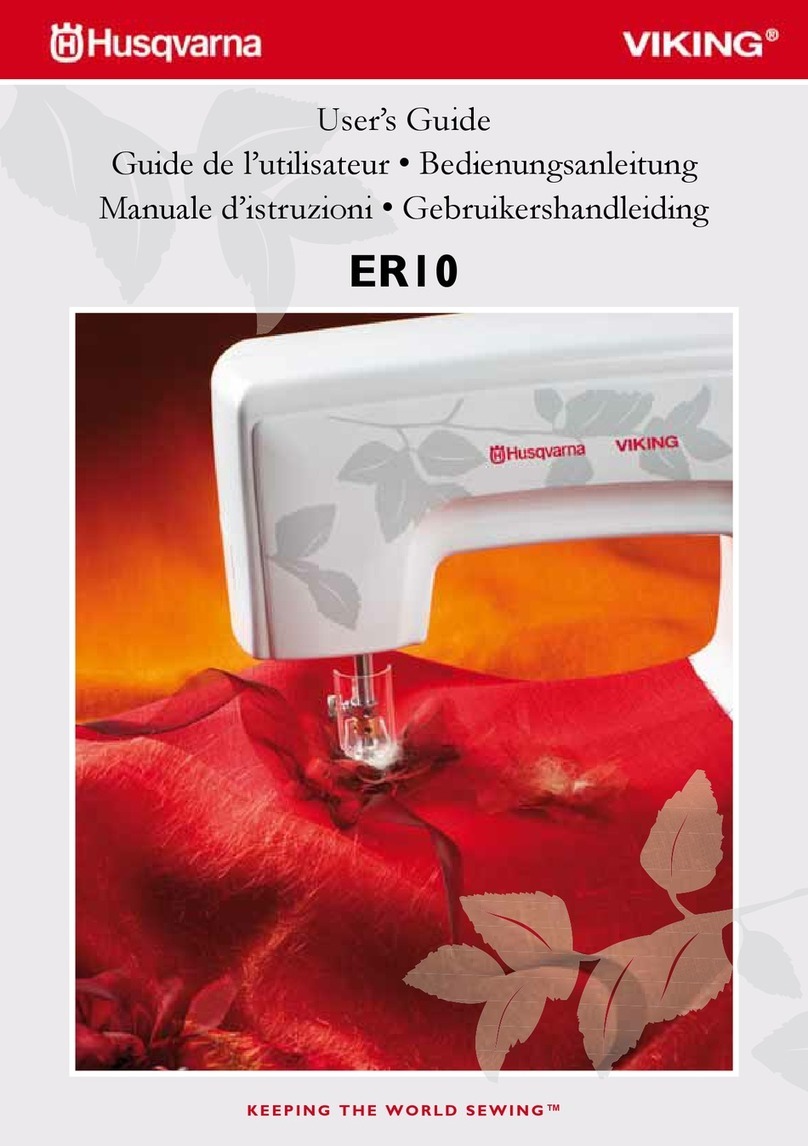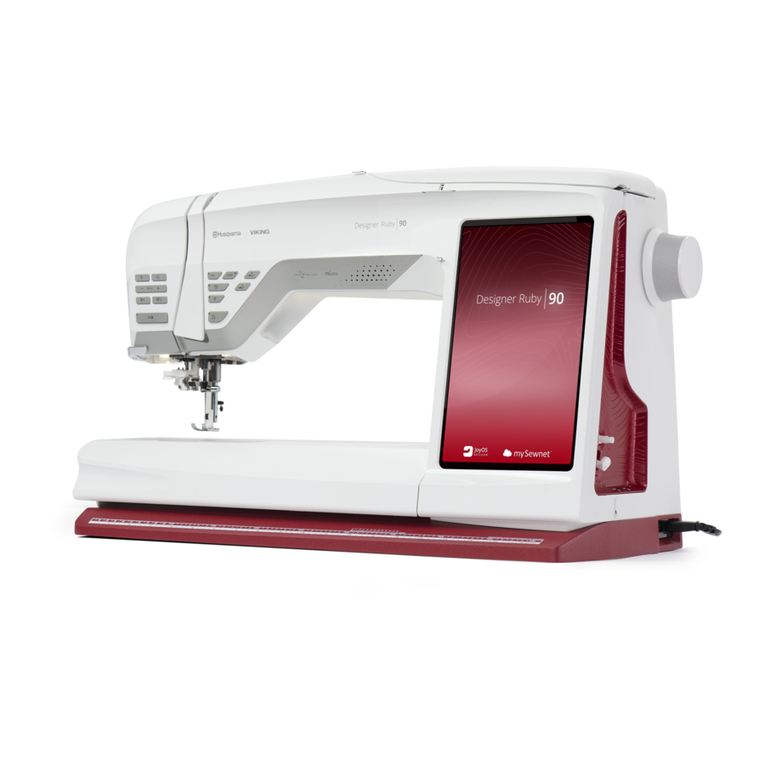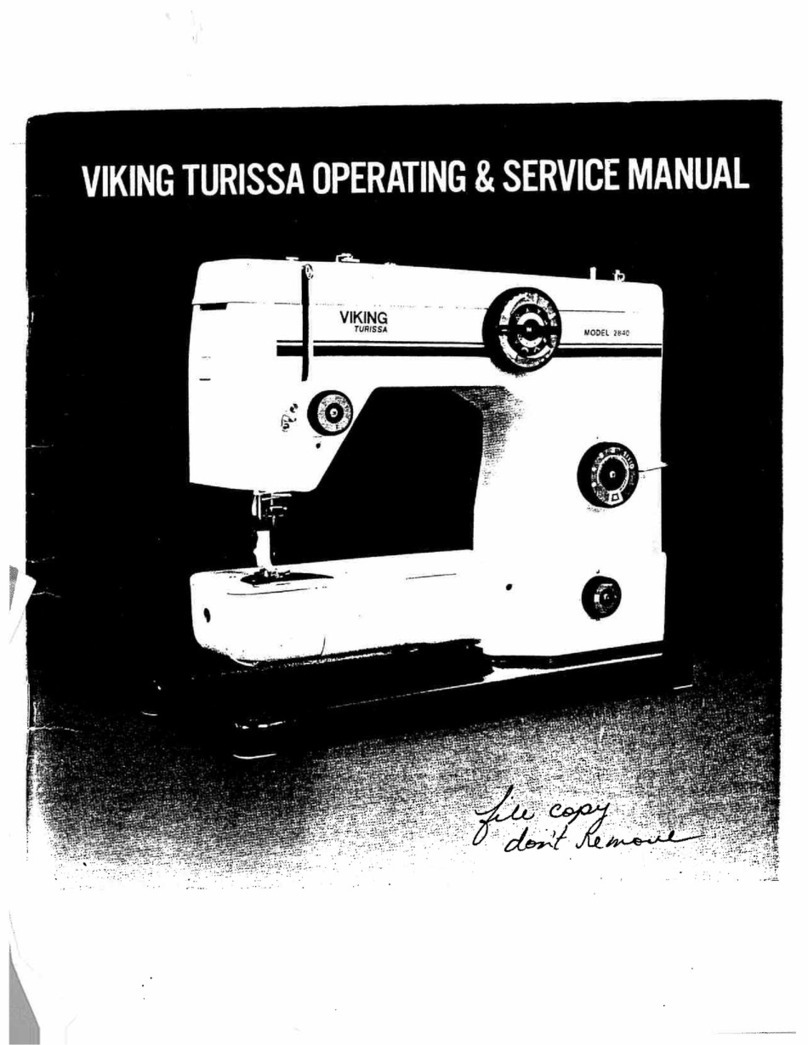Viking Designer Topaz User manual

User’s Guide
KEEPING THE WORLD SEWING™

This household sewing machine is designed to comply with IEC/EN 60335-2-28 and UL1594
IMPORTANT SAFETY INSTRUCTIONS
When using an electrical appliance, basic safety precautions should always be followed, including the following:
Read all instructions before using this household sewing machine.
DANGER –To reduce the risk of electric shock:
• A sewing machine should never be left unattended when plugged in. Always unplug this sewing machine
from the electric outlet immediately after using and before cleaning.
• Always unplug before relamping. Replace bulb with same type rated 5 Watt.
WARNING –To reduce the risk of burns,Àre,electric shock,
or injury to person:
• This sewing machine is not intended for use by persons (including children) with reduced physical, sensory or mental
capabilities, or lack of experience and knowledge, unless they have been given supervision or instruction concerning use of
the sewing machine by a person responsible for their safety.
• Children should be supervised to ensure that they do not play with the sewing machine.
• Use this sewing machine only for its intended use as described in this manual. Use only attachments
recommended by the manufacturer as contained in this manual.
• Never operate this sewing machine if it has a damaged cord or plug, if it is not working properly, if it has
been dropped or damaged, or dropped into water. Return the sewing machine to the nearest authorized
dealer or service center for examination, repair, electrical or mechanical adjustment.
• Never operate the sewing machine with any air openings blocked. Keep ventilation openings of the
sewing machine and foot controller free from the accumulation of lint, dust, and loose cloth.
• Keep Àngers away from all moving parts. Special care is required around the sewing machine needle.
• Always use the proper needle plate. The wrong plate can cause the needle to break.
• Do not use bent needles.
• Do not pull or push fabric while stitching. It may deÁect the needle causing it to break.
• Wear safety glasses.
• Switch the sewing machine off (“0”) when making any adjustment in the needle area, such as threading
needle, changing needle, threading bobbin, or changing presser foot, etc.
• Always unplug sewing machine from the electrical outlet when removing covers, lubricating, or when
making any other user servicing adjustments mentioned in the instruction manual.
• Never drop or insert any object into any opening.
• Do not use outdoors.
• Do not operate where aerosol (spray) products are being used or where oxygen is being administrated.
• To disconnect, turn all controls to the off (“0”) position, then remove plug from outlet.
• Do not unplug by pulling on cord. To unplug, grasp the plug, not the cord.
• This sewing machine is provided with double insulation. Use only identical replacement parts.
See instructions for Servicing of Double-Insulated Appliances.
SAVETHESE INSTRUCTIONS
SERVICING OF DOUBLE INSULATED PRODUCTS
In a double-insulated product, two systems of insulation are provided instead of grounding. No ground means is provided
on a double-insulated product, nor should a means for grounding be added to the product. Servicing of a double-insulated
product requires extreme care and knowledge of the system and should be done only by qualiÀed service personnel.
Replacement parts for a double-insulated product must be identical to those parts in the product. A double-insulated product
is marked with the words ‘DOUBLE INSULATION’ or ‘DOUBLE INSULATED’.

1
2
2
3
4
Set Up
Page 10-31
Sewing Mode
Page 32-44
Embroidery Set Up
Page 55-58
Taking care of the
machine
Page 68-70
Stitch and alphabet overview,page 71-73
Machine overview and accessories,page 6-9
Embroidery Mode
Page 59-67
Basic Sewing
Techniques
Page 45-54
5
6

Table of contents
Machine overview............................................................6
Included accessories........................................................8
1.Set Up
Unpacking........................................................................10
Connecting the foot control cord..............................10
Connect the power cord and foot control..............10
Packing away after sewing............................................11
Extended Sewing Surface.............................................11
Using the free arm.........................................................11
Spool pins and spool caps............................................12
Threading the UpperThread.......................................13
Needle threader.............................................................14
Cutting the thread.........................................................14
Threading for twin needles..........................................15
Thread sensor.................................................................15
BobbinWinding,model 20...........................................16
BobbinWinding,model 30...........................................17
Inserting the bobbin......................................................18
Thread tension................................................................19
EXCLUSIVE SENSOR SYSTEM™ (ESS)...................19
Lower the feed teeth....................................................20
Changing the presser foot............................................20
Changing the needle......................................................20
Needles............................................................................21
Threads.............................................................................22
Pictogram Pen.................................................................22
Stabilizers.........................................................................22
USB port..........................................................................23
USB embroidery stick...................................................23
5D™ Embroidery Software.........................................24
How to Update your machine....................................24
Function Buttons............................................................25
Touch Panel overview...................................................27
SET Menu.........................................................................28
2.Sewing Mode
Sewing Mode overview.................................................32
Selecting a stitch
.............................................................33
Selecting a font...............................................................33
Exclusive SEWINGADVISOR™................................34
Stitch Settings..................................................................35
Programming...................................................................37
My Stitches Menu...........................................................40
Sewing pop-up messages..............................................41
3.Basic SewingTechniques
Seam..................................................................................45
Overcast...........................................................................45
Seam and Overcast........................................................46
Baste..................................................................................47
Darning and Mending....................................................47
Hem...................................................................................48
Blind Hem........................................................................49
Sewing buttonholes.......................................................50
Sewing on buttons.........................................................52
Sewing zippers................................................................53
Taper Satin Stitch,model 30........................................54
4.Embroidery Set Up
Embroidery unit overview...........................................55
Embroidery hoop overview.........................................55
Designs.............................................................................55
Connect the embroidery unit.....................................56

Remove the embroidery unit......................................56
Hoop the fabric..............................................................57
Slide on the hoop...........................................................57
Getting started embroidering.....................................58
5.Embroidery Mode
Embroidery Mode overview........................................59
Load a design...................................................................60
Load a font.......................................................................60
Embroidery information...............................................61
Adjust designs.................................................................62
Hoop options..................................................................63
Embroidery functions....................................................64
Embroidery pop-up messages.....................................65
4.Taking care of the machine
Changing the light bulbs...............................................68
Cleaning the machine....................................................68
Trouble shooting............................................................69
Stitch table - menu 1.Utility stitches.........................71
Stitch overview...............................................................73
Alphabets.........................................................................73
Index.................................................................................74

1
2
4
5
7
3
8
9
11
12
13
14
10
15
19
20
21
22
23
25
26
28
30
24
31
32
9
34
33
29
16
27
6
18
17
6
Machine overview
1. Lid
2. Pre-Tension thread guide
3. Thread tension discs
4. Thread take-up lever
5. Thread tension for bobbin winding
6. Thread slots
7. Function Button Panel
8. Thread cutter
9. Light bulbs
10. Sensor One-Step Buttonhole Foot
socket
11. Built-In Needle threader
12. Presser foot
13. Stitch plate
14. Bobbin cover
15. Free arm
16. Drop feed teeth switch
17. Button ruler and built-in tape measure
18. Base plate
19. Needle bar with needle clamp screw
20. Presser bar
21. Presser foot ankle
22. Stitch panel
23. Main spool pin
24. Spool caps
25. Auxiliary spool pin
26. Bobbin winding lever (model 30)
27. Bobbin winder (model 30)
28. Thread cutter for bobbin winding
(model 30)
29. Bobbin winding thread guide
30. Handwheel
31. GraphicDisplay
32. Touch Panel
33. Built-in USB port
34. ON/OFF switch, connectors for
power cord and foot control
Front side

39
38
40
41
43
44
42
46
45
35
36
37
7
35. Bobbin stop (model 20)
36. Bobbin winder (model 20)
37. Thread cutter for bobbin winding (model 20)
Rear side
38. Handle
39. Embroidery unit connection socket
Parts of the embroidery unit
(For model 30 type BE18, for model 20 type BE19)
40. Embroidery unit socket
41. Embroidery arm
42. Embroidery unit release button (underside)
43. Embroidery hoop attachment
44. Level adjusting feet
Accessory tray
There are special places for presser feet and bobbins in the
accessory tray, plus space for needles and other accessories. Store
the accessories in the tray so they are easily accessible.
45. Space for accessories
46. Removable presser feet and bobbin holder

64
63
62
47
48 49
50 51
52 53 54
55
56
57 58
60
59
61
8
Included accessories
47. 2 thread nets. Slide on the spool when using synthetic threads
that easily unwind.
48. Screwdriver
49. Ligth bulb remover
50. Seam ripper
51. Brush
52. 2 non-Stick glide plates
53. 2 felt pads
54. 2 spool caps, large (1 attached to the machine upon delivery)
55. Spool cap, small
56. Spool cap, medium (attached to the machine upon delivery)
57. 6 bobbins (one in machine upon delivery)
58. Multipurpose tool/Button reed
59. USB embroidery stitck (1 GB)
60. Hoop Clips (16 with model 30, 10 with model 20)
61. Pictogram Pen
Hoops Included
62. DESIGNER™ Royal Hoop, 360x200mm (Only with model 30)
63. DESIGNER™ Crown Hoop, 260x200mm (Only with model 20)
64. DESIGNER™ Splendid Square Hoop, 120x120mm
Accessories Included - not in picture
• Scissors
• Needles
• Carrying case (attached on the machine upon delivery)
• Foot control
• Foot control cord
• Power cord
• Embroidery thread
• Pieces of fabric and stabilizer
• 5D™ Embroidery Machine Communication CD
• DESIGNER TOPAZ™ Sampler CD
• DESIGNER TOPAZ™ 30 Bonus Sampler CD (Only with
model 30)
• DESIGNER TOPAZ™ Sampler Book
• User´s Guide
• Quick Guide
• Accessory User’s Guide
• Warranty card

9
Presser feet
7Utility Foot A Attached on the machine upon delivery. This foot is used mainly for
straight stitching and zigzag stitching with a stitch length longer than 1.0.
7Decorative Stitch
Foot B When sewing decorative stitches or short zigzag stitches and other utility
stitches with less than 1.0 mm stitch length, use this foot. The tunnel on
the underside of the foot is designed to feed smoothly over the stitches.
7Buttonhole Foot C This foot is used for sewing buttonholes step by step. Use the guide lines
on the toe of the foot to position the garment edge. The two tunnels
on the bottom of the foot ensures a smooth feed over the buttonhole
columns. The Ànger on the back of the foot holds cording for corded
buttonhole.
Blind Hem Foot D This foot is used for blind hem stitches. The inner edge of this foot
guides the fabric. The right toe of the foot is designed to ride along the
hem edge.
7Zipper Foot E This foot can be snapped on either to the right or to the left of the
needle, making it easy to sew close to both sides of the zipper teeth.
Move needle position to right or left to sew closer to zipper teeth or for
covering large cording.
7Non-Stick Glide
Foot H This foot, with a non-stick coating underneath, is used when sewing
foam, vinyl, plastic or leather to minimize the risk of these materials
sticking to the foot.
Edging Foot J This foot is used for overcasting and seam/overcasting. Stitches form
over the pin which prevents puckering at the edge of the fabric.
Embroidery/
Darning Foot R This foot is used for free motion embroidery/quilting/stitching and hoop
embroidery.
7Decorative Stitch Foot
B Transparent A clear foot for decorative sewing makes it easy to match stitches. Same
tunnel on the underside as Presser Foot B.
7
Sensor One-Step
Buttonhole Foot When connected to the machine, the buttonhole is sewn in a suitable
length to the button size that has been entered into the machine.

OFF
ON
123
10
Set Up
1.Set Up
Unpacking
1. Place the machine on a sturdy, Áat surface, remove the
packaging and lift off the cover.
2. Remove the packing material and the foot control.
3. The machine is delivered with an accessory bag, a power cord
and a foot control cord.
4. Wipe the machine, particularly around the needle and stitch
plate to remove any soil before sewing.
Connecting the foot control cord
Among the accessories you will Ànd the foot control cord and
the power cord. Connecting the foot control cord to the foot
control is only necessary the very Àrst time you are going to use
the machine.
1. Take out the foot control cord. Turn the foot control over.
Connect the cord to the socket inside the space of the foot
control.
2. Push Àrmly to make sure it is properly connected.
3. Lay the cord in the slot on the underside of the foot control.
Connect the power cord and foot
control
On the underside of the machine you will Ànd information about
the power supply voltage (V) and the frequency (Hz).
Note: Before plugging in the foot control, check to ensure that it is of type
“FR5” (see underside of foot control).
1. Connect the foot control cord to the front socket on the
bottom right side of the machine (1).
2. Connect the power cord to the rear socket on the bottom
right side of the machine (2).
3. Press the ON/OFF switch to ON to turn on power and light
(3).
For the USA and Canada
This sewing machine has a polarized plug (one blade wider
than the other). To reduce the risk of electric shock, this
plug is intended to Àt in a polarized outlet only one way. If
the plug does not Àt fully in the outlet, reverse the plug. If
it still does not Àt, contact a qualiÀed electrician to install
the proper outlet. Do not modify the plug in any way.

11
1
Set Up
Packing away after sewing
1. Press the ON/OFF switch (3) to OFF.
2. Unplug the cord from the wall socket and then from the
machine (2).
3. Unplug the foot control cord from the machine (1). Wind the
foot control cord inside the space on the underside of the
foot control.
4. Place all accessories in the accessory tray. Slide the tray on to
the machine, behind the free arm.
5. Place the foot control in the space above the free arm.
6. Put on the cover.
Extended Sewing Surface
The space at the right side of the needle, between the needle
and the arm, gives you a great deal of extra space. This makes
sewing large projects and quilts much easier than on other sewing
machines. Keep the accessory tray on the machine to provide a
large, Áat work surface.
Using the free arm
Slide the accessory tray to the left when you wish to remove it and
use the free arm.
Use the free arm to facilitate sewing trouser legs and sleeve hems.
To replace the accessory tray, slide it onto the machine until it Àts
in place.

A
B
12
Set Up
Spool pins and spool caps
Your sewing machine has two spool pins; a main spool pin and
an auxiliary spool pin. The spool pins are designed for all types
of thread. The main spool pin is adjustable and can be used in a
horizontal position (the thread reels off the stationary spool) or
in a vertical position (the thread spool rotates). Use the horizontal
position for all regular sewing threads and the vertical position for
large spools or specialty threads.
Horizontal position
Lift the spool pin up slightly from its horizontal position to easily
place the thread spool on the pin. The thread should reel over
the top, in a counterclockwise direction, as shown in the picture.
Slide on a spool cap and then move the spool pin back to the
horizontal position.
There are two spool caps on the spool pin upon delivery. For
medium sized thread spools, the medium sized cap (A) is placed
in front of the spool. For large thread spools, the large cap (B) is
placed in front of the spool.
The Áat side of the spool cap should be pressed Àrmly against the
spool. There should be no space between spool cap and thread
spool.
Two extra spool caps, one small and one large, are also included
as accessories for your machine. The small spool cap can be used
for small thread spools. The second large spool cap can be used
when winding a bobbin from a second spool of thread or when
sewing with a twin needle.
Vertical position
Lift the spool pin up and all the way to the right. Lock the spool
pin in the vertical position by slightly pressing it down. Slide on
the large spool cap. For spools smaller than the medium size
spool cap or when using specialty threads, place a felt pad under
the thread spool to prevent the thread from reeling off too fast.
For larger spools, the felt pad is not needed.
Note: No spool cap should be placed on top of the spool as this prevents the
spool from rotating.
Auxiliary spool pin
The auxiliary spool pin is used when winding a bobbin from a
second spool of thread or for a second spool when sewing with a
twin needle.
Lift the auxiliary spool pin up and to the left. Slide on the large
spool cap. For spools smaller than the medium size spool cap,
place a felt pad under the thread spool to prevent the thread from
reeling off too fast. For larger spools, the felt pad shall not be
used.

A
B
C
D
E
13
1
Set Up
Threading the UpperThread
Make sure the presser foot is raised and the needle is in the up
position.
1. Place the thread on the spool pin and the spool cap on the
spool as described on page 12.
2. Spool pin in horizontal position:
Bring the thread over and behind the pre-tension thread guide
(A) and under the thread guide (B).
Spool pin in vertical position:
Instead of bringing the thread into the pre-tension guide (A),
bring it directly under the thread guide (B).
3. Bring the thread down between the thread tension discs (C).
4. Continue threading in the direction indicated by the arrows.
Bring the thread from the right into the slot on the take-up
lever (D).
5. Take the thread down and behind the last guide just above the
needle (E).

12
3
4
A
B
C
14
Set Up
Needle threader
The needle must be in the up position to use the built-in needle
threader. We also recommend lowering the presser foot.
1. Use the handle to pull the needle threader all the way down,
catching the thread under the guide (A).
2. Push back to bring the needle threader forward until the metal
Áanges cover the needle. A small hook will pass through the
needle eye (B).
3. Place the thread under the Áanges in front of the needle, so
the thread catches into the small hook (C).
4. Let the needle threader gently swing back. The hook pulls the
thread through the needle eye and forms a loop behind the
needle. Pull the thread loop out behind the needle.
5. Place the thread under the presser foot.
Note: The needle threader is designed to be used for size 70-120 needles. You
cannot use the needle threader for size 60 needles or smaller, the wing needle,
twin needle, triple needle or when the Sensor One-Step Buttonhole Foot is on.
There are also some other optional accessories that require manual threading
of the needle.
When threading the needle manually, make sure that the needle is threaded
from front to back. The white presser foot ankle makes it easy to see the eye
of the needle. The bobbin case cover can be used as a magnifying glass.
Cutting the thread
Once you have Ànished sewing, you can cut the threads by raising
the presser foot and pulling the threads on the left side of the
machine from back to front into the thread cutter.

A
D
B
15
1
Set Up
Threading for twin needles
1. Insert a twin needle.
2. Use a second thread spool or wind a bobbin with the thread
you are going to use as the second upper thread.
3. Lift the spool pin up and all the way to the right. Lock the
spool pin in the vertical position by slightly pressing it down.
Slide on the large spool cap. For spools smaller than the
medium size spool cap, place a felt pad under the thread
spool.
4. Place the Àrst thread spool on the spool pin. The spool
should rotate in a clockwise direction when the thread reels
off the spool.
5. LEFT NEEDLE: Thread the machine as described on page 13.
Check to ensure that the thread lies between the left thread
tension discs (A). Thread the left needle manually.
6. Pull out the auxiliary spool pin and slide on the large spool
cap. For spools smaller than the medium size spool cap, place
a felt pad under the thread spool.
7. Place the second thread on the spool pin. The second spool
should rotate in a counterclockwise direction when the thread
reels off the spool.
8. RIGHT NEEDLE:Thread the machine as before but this thread
should lie between the right thread tension discs (A) and
outside the needle thread guide (B). Thread the right needle
manually.
Note: Only use symmetrical twin needles (C). Do not use this type of twin
needle (D), since it may damage your sewing machine.
Thread sensor
If the upper thread breaks or runs out or if the bobbin thread
runs out, the machine stops and a pop-up appears on the display.
If upper thread breaks: Re-thread the machine and press OK.
The pop-up disappears. If bobbin thread runs out; replace with a
full bobbin and continue sewing.
C

C
A
BC
D
16
Set Up
BobbinWinding,model 20
Winding the bobbin with the
machine threaded
Make sure that the presser foot is up and the needle is in the
highest position.
Note! Do not use a plastic presser foot when bobbin winding.
1. Place an empty bobbin on the bobbin winder on the top
of the machine. The bobbin only Àts on one way, with the
logo facing up. Use only original HUSQVARNA VIKING®
bobbins.
2. Thread the machine with the main spool pin in the horizontal
position.
Note: If the thread spool is too large to be in horizontal position, wind
the bobbin as described under “Winding Specialty Threads” below.
3. Pull the thread from the needle under the presser foot and to
the right through the bobbin winding thread guide (C).
4. Guide the thread through the hole in the bobbin (D) from the
inside to the outside.
5. Push the bobbin winder to the right. A pop-up message
appears on the GraphicDisplay. Press the foot control or
the Start/Stop button to start winding. Hold the end of the
thread Àrmly when starting to wind. Once the bobbin begins
to wind, cut the excess thread.
When the bobbin is full, it will stop automatically. Push the
bobbin winder back to the left, remove the bobbin and cut
off the thread on the thread cutter.
Winding SpecialtyThreads
We do not recommend winding speciality threads such as
“invisible” or other stretchy threads, metallic or Áat metallic
threads through the needle.
Always wind these threads at minimum speed.
1. Place an empty bobbin on the bobbin winder on the top
of the machine. The bobbin only Àts on one way, with the
logo facing up. Use only original HUSQVARNA VIKING®
bobbins.
2. Place the large spool cap and a felt pad under the spool on the
main spool pin set in the vertical position.
3. Bring the thread over and behind the pre-tension thread
guide (A) and down around the thread tension disc (B), then
through bobbin winding thread guide (C) as illustrated.
4. See Winding the bobbin with the machine threaded, step 4-5.
Note: Depending on the type of thread, wrap the thread one or two
turns around the bobbin thread tension disc (B) to put more tension
on the thread. Embroidery weight bobbin thread should be taken two
turns around the bobbin thread tension disc.
Note: When using earlier version of HUSQVARNA
VIKING® bobbins that do not have a hole, wind several
turns of thread on the bobbin to get started.

C
A
BC
D
17
1
Set Up
BobbinWinding,model 30
Winding the bobbin with the
machine threaded
Make sure that the presser foot is up and the needle is in the
highest position.
Note! Do not use a plastic presser foot when bobbin winding.
1. Place an empty bobbin on the bobbin winder on the top
of the machine. The bobbin only Àts on one way, with the
logo facing up. Use only original HUSQVARNA VIKING®
bobbins.
2. Thread the machine with the main spool pin in the horizontal
position.
Note: If the thread spool is too large to be in horizontal position, wind
the bobbin as described under “Winding Specialty Threads” below.
3. Pull the thread from the needle under the presser foot and to
the right through the bobbin winding thread guide (C).
4. Guide the thread through the hole in the bobbin (D) from the
inside to the outside.
5. Push the bobbin winder lever towards the bobbin to wind.
A pop-up message appears on the GraphicDisplay. Press the
OK button to start winding. To adjust the winding speed use
the left/right arrow buttons. Hold the thread Àrmly when
starting to wind. Once the bobbin begins to wind, cut the
excess thread.
Once the bobbin is full, the bobbin winder lever will move
back and the winding will stop automatically. The pop-up
message closes. Remove the bobbin and cut the thread using
the bobbin thread cutter.
Winding SpecialtyThreads
We do not recommend winding speciality threads such as
“invisible” or other stretchy threads, metallic or Áat metallic
threads through the needle.
Always wind these threads at minimum speed.
1. Place an empty bobbin on the bobbin winder on the top
of the machine. The bobbin only Àts on one way, with the
logo facing up. Use only original HUSQVARNA VIKING®
bobbins.
2. Place the large spool cap and a felt pad under the spool on the
main spool pin set in the vertical position.
3. Bring the thread over and behind the pre-tension thread
guide (A) and down around the thread tension disc (B), then
through bobbin winding thread guide (C) as illustrated.
4. See Winding the bobbin with the machine threaded, step 4-5.
Note: Depending on the type of thread, wrap the thread one or two
turns around the bobbin thread tension disc (B) to put more tension
on the thread. Embroidery weight bobbin thread should be taken two
turns around the bobbin thread tension disc.
Note: When using earlier version of HUSQVARNA
VIKING® bobbins that do not have a hole, wind several
turns of thread on the bobbin to get started.

BC
E
F
G
12
34
I
H
D
18
Set Up
BobbinWinding while embroidering or
sewing
Model 30 has a separate motor for bobbin winding to wind
bobbins while sewing or embroidering.
1. Place an empty bobbin on the bobbin winder on the top
of the machine. The bobbin only Àts on one way, with the
logo facing up. Use only original HUSQVARNA VIKING®
bobbins.
2. Raise the auxiliary spool pin. Place the large spool cap, felt
pad and thread spool on the spool pin.
3. Bring the bobbin thread around the thread tension disc (B)
and through the thread guide (C) as illustrated.
4. Guide the thread through the hole in the bobbin (D) from the
inside to the outside.
5. Push the bobbin winder lever towards the bobbin to wind.
A pop-up message appears on the GraphicDisplay. Press the
OK button to start winding. To adjust the winding speed use
the left/right arrow buttons. Hold the thread Àrmly when
starting to wind. Once the bobbin begins to wind, cut the
excess thread.
Once the bobbin is full, the bobbin winder lever will move
back and the winding will stop automatically. The pop-up
message closes. Remove the bobbin and cut the thread using
the bobbin thread cutter.
Note: Make sure that the thread does not touch the cap of the horizontal
spool pin when winding the bobbin. If it does, place the cap and spool on
the vertical spool pin higher.
Inserting the bobbin
1. Remove the bobbin cover by sliding it towards you.
2. Place the bobbin in the bobbin case. It drops in only one way
with the logo facing up. The thread unreels from the left of
the bobbin. The bobbin will then rotate counter-clockwise
when you pull the thread.
3. Place your Ànger on the bobbin to keep it from turning as you
pull the thread Àrmly to the right and then to the left into the
tension spring (E) until it “clicks” into place.
4. Continue threading around (F) and to the right of the thread
cutter (G). Slide on the bobbin cover (H). Pull the thread to
the left to cut (I).
Note: When using earlier version of HUSQVARNA
VIKING® bobbins that do not have a hole, wind several
turns of thread on the bobbin to get started.

1
2
3
19
1
Set Up
Thread tension
Your machine automatically sets the best thread tension for the
selected stitch and fabric. Go to the SET Menu to adjust the
thread tension for specialty thread, techniques or fabric (see page
28).
Correct and incorrect thread tension
For the best stitch appearance and durability make sure the needle
thread tension is correctly adjusted, i.e. for general sewing, the
threads evenly meet between the two fabric layers (1).
If the bobbin thread is visible on the top side of the fabric, the
needle thread tension is too tight (2). Reduce the needle thread
tension.
If top thread is visible on the underside of the fabric, the needle
thread tension is too loose (3). Increase the needle thread tension.
Note: For decorative stitches and buttonholes the top thread should be visible
on the underside of the fabric.
EXCLUSIVE SENSOR SYSTEM™
(ESS)
Sensor Foot Pressure
Thanks to the Sensor Foot Pressure, the presser foot actually
senses the thickness of fabric, embroidery or stitching to sew
over it smoothly and evenly with perfect fabric feeding.
If you want to see the actual setting of the presser foot pressure
for the selected fabric and adjust the pressure manually, go to the
SET Menu (see page 28).
Sensor Foot Lift
The presser foot on your sewing machine is raised and lowered in
four levels with the Sensor Foot Up and Down buttons (see page
25).
The presser foot is automatically lowered when you start sewing.
When you stop with the needle in the down position, the presser
foot automatically senses the thickness of the fabric and raises
the presser foot to just the right height to Áoat over the fabric for
pivoting. Go to the SET Menu to turn off this function (see page
28).

12
20
Set Up
Lower the feed teeth
The feed teeth are lowered when you move the switch on the
front of the free arm to the right. Move the switch to the left if
you wish to raise the feed teeth. The feed teeth will raise as you
begin to sew. The feed teeth should be lowered when sewing on
buttons and for free motion sewing.
When embroidering, the feed teeth are lowered automatically as
the embroidery unit is connected. When the embroidery unit is
removed, the feed teeth are raised automatically when you start
sewing.
Changing the presser foot
Turn off the ON/OFF switch
1. Make sure the needle is in the highest position and the presser
foot lifted. Pull the presser foot towards you.
2. Line up the cross pin on the foot with the gap in the presser
foot ankle. Push back until the foot snaps into place.
Changing the needle
Turn off the ON/OFF switch
1. Use the hole in the multipurpose tool to hold the needle.
2. Loosen the screw in the needle clamp with the screwdriver.
3. Remove the needle.
4. Insert the new needle using the multipurpose tool. Push the
new needle upwards with the Áat side away from you until it
will go no further.
5. Use the screwdriver to tighten the screw.
Table of contents
Other Viking Sewing Machine manuals
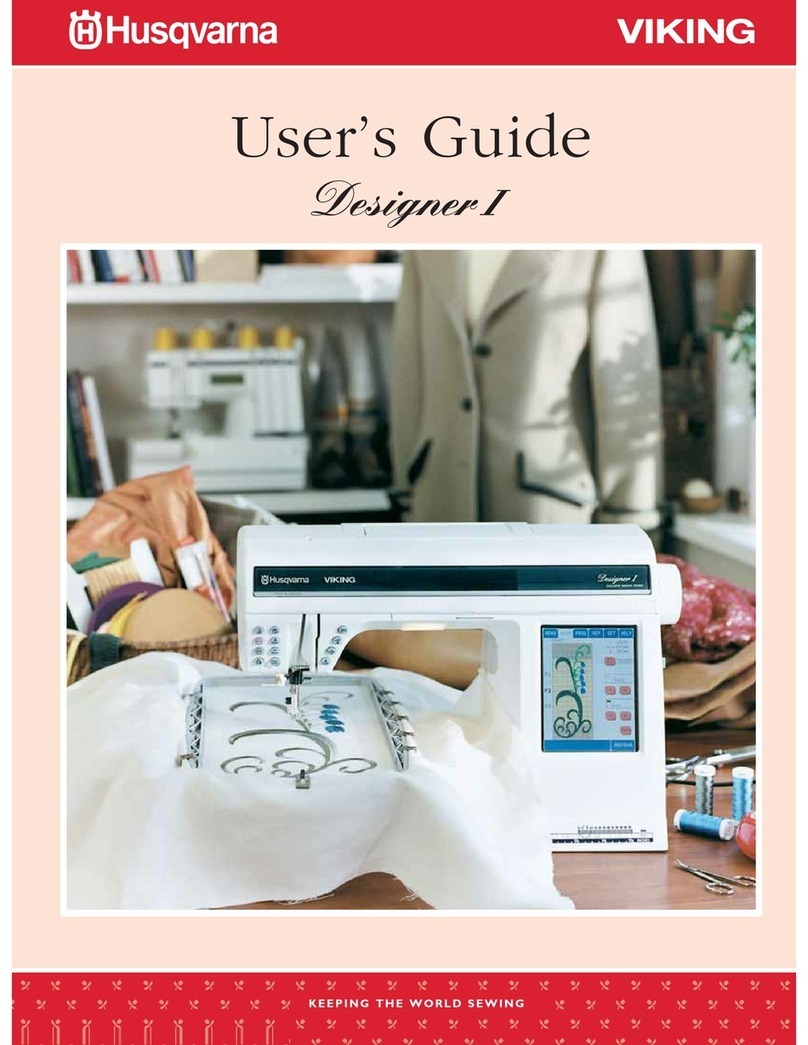
Viking
Viking Designer I User manual

Viking
Viking 3260 User manual

Viking
Viking Huskystar C10 User manual
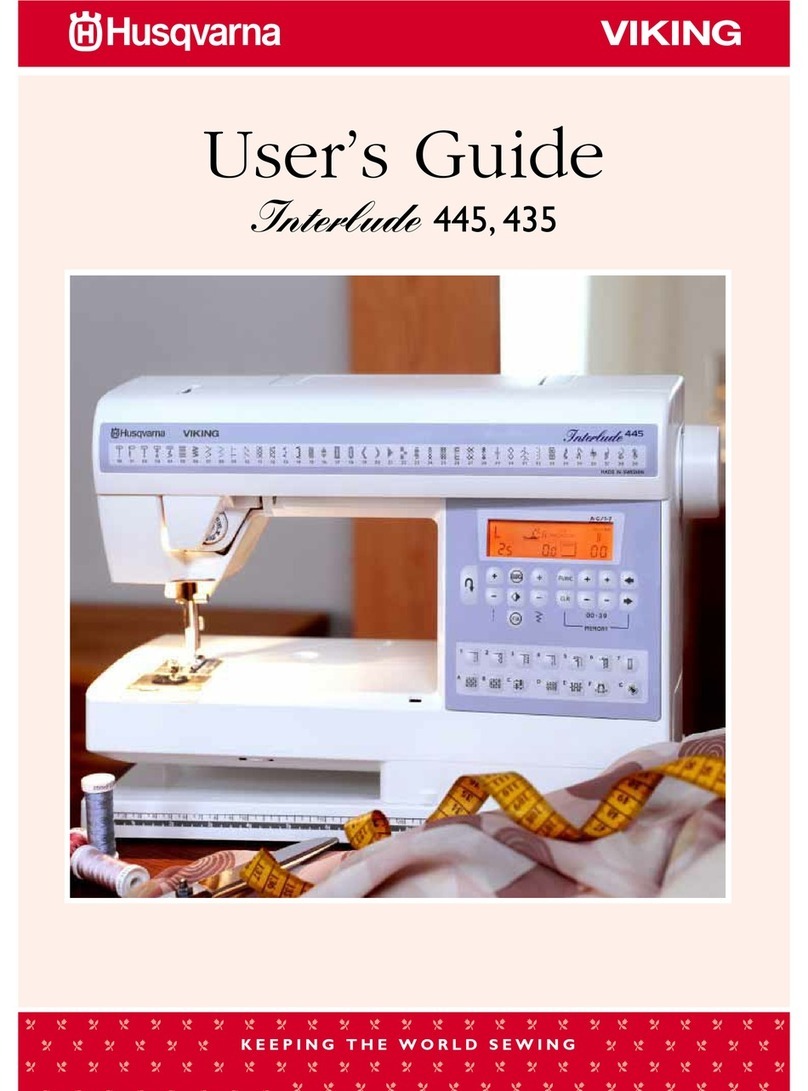
Viking
Viking Interlude 445 User manual
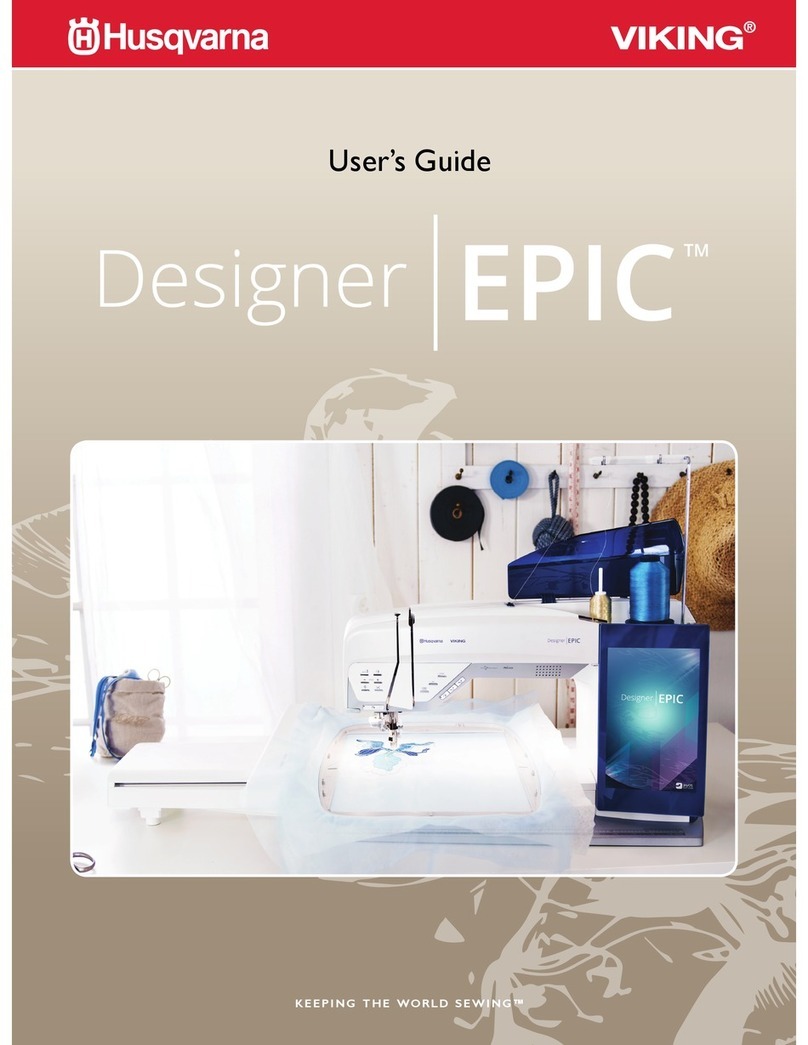
Viking
Viking Designer EPIC User manual
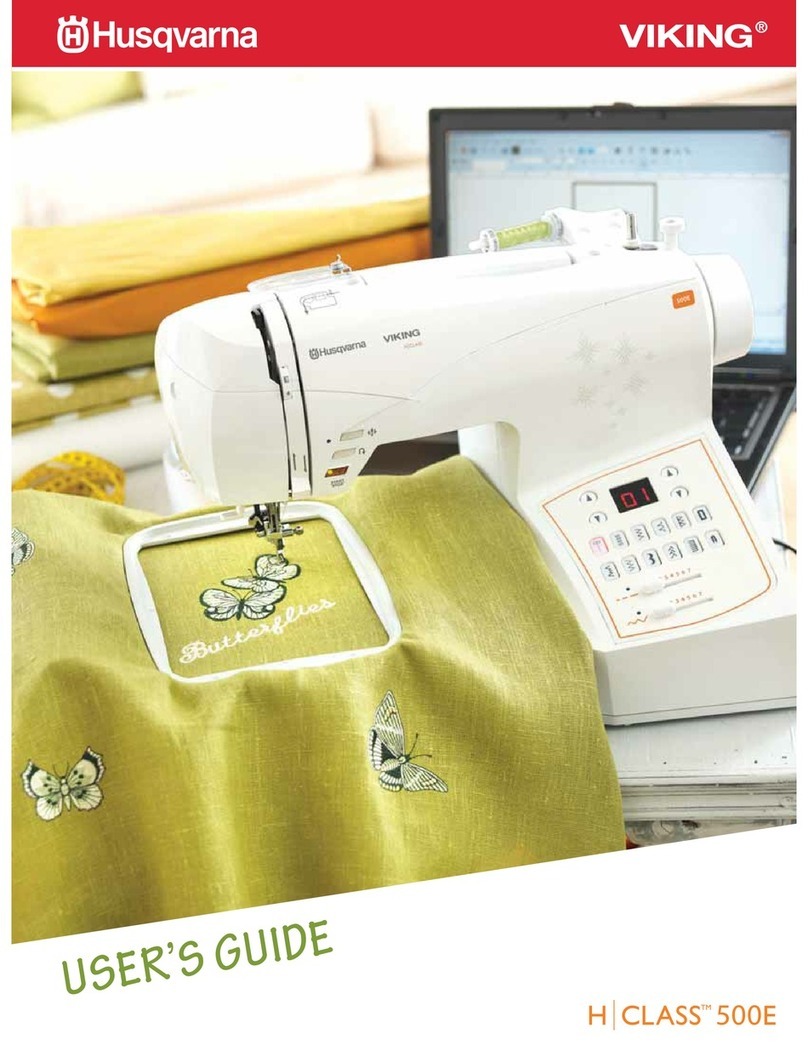
Viking
Viking H|Class 500E User manual

Viking
Viking Huskystar 215 User manual

Viking
Viking Huskylock S15 User manual

Viking
Viking Huskystar 207 User manual
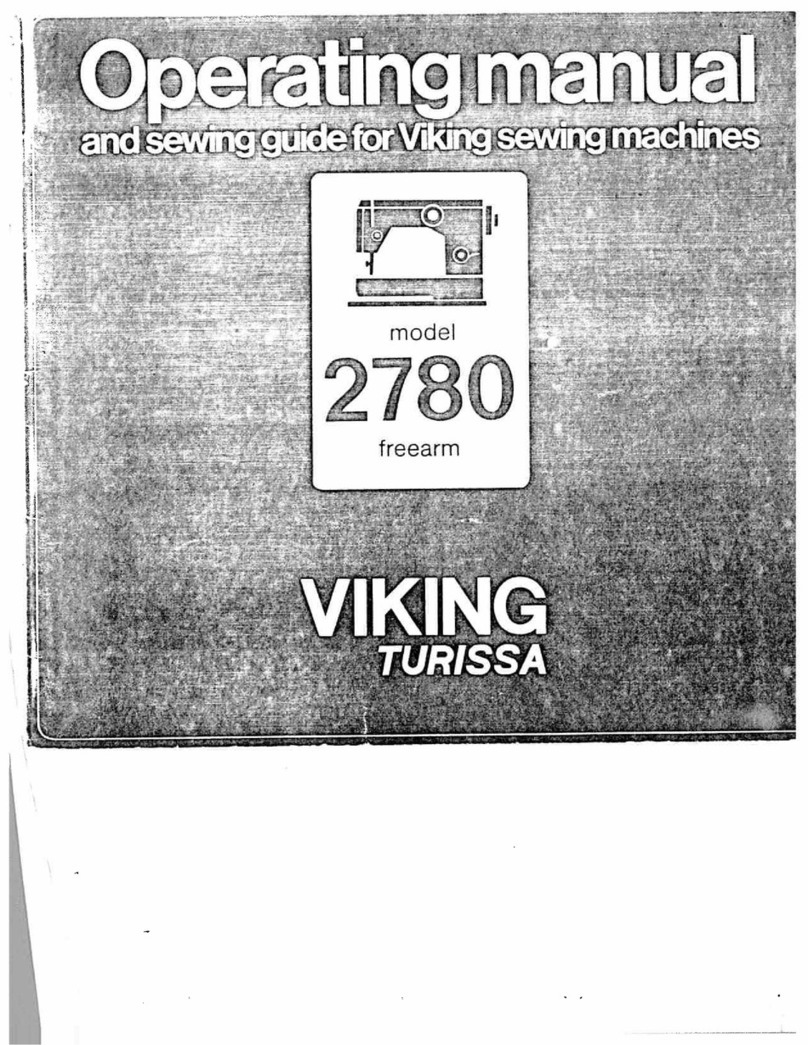
Viking
Viking 2780 User manual
